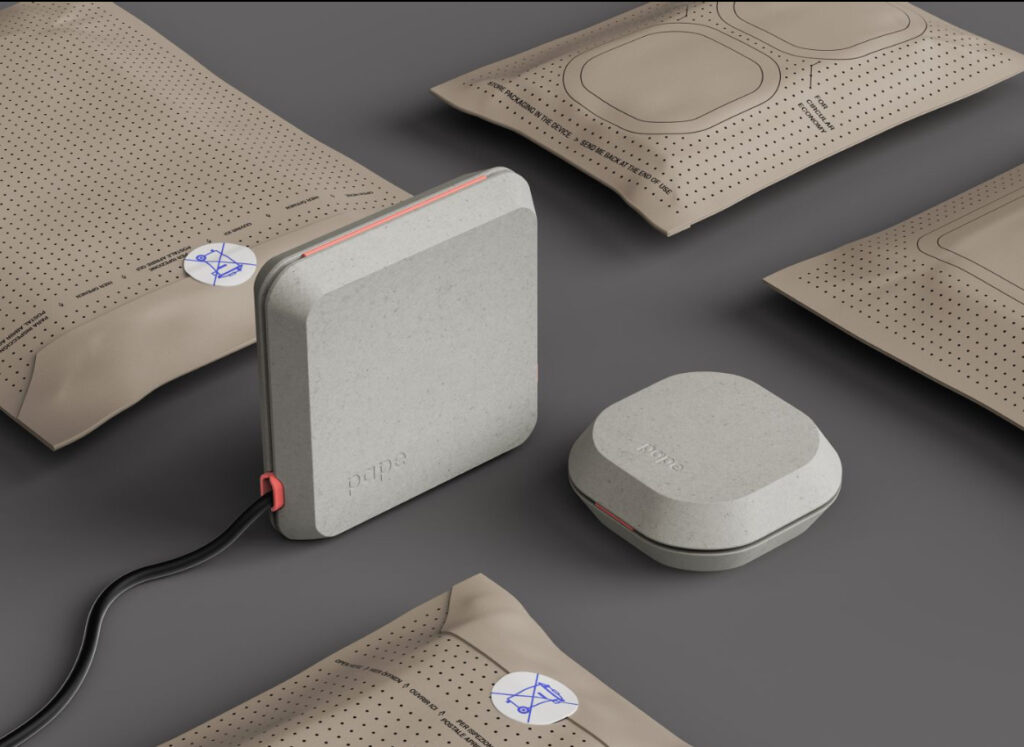In a world increasingly dominated by electronic devices, the mounting problem of e-waste is a critical environmental challenge. Many devices, while indispensable to our daily lives, contribute to a cycle of waste that is difficult to break. Enter PAPE, a groundbreaking innovation crafted by designer Franziska Kerber. This device, made from densely pressed paper fibers and a dissolvable, recyclable PCB board, doesn’t just aim to reduce e-waste—it eliminates it entirely. By integrating environmentally friendly materials with cutting-edge design principles, PAPE represents a significant step toward a sustainable future for electronics.
The Problem with E-Waste
E-waste, or electronic waste, refers to discarded electronic devices and their components, ranging from smartphones to computers and household appliances. According to the United Nations, the world generates over 50 million tons of e-waste annually, and this figure is expected to grow. Much of this waste contains hazardous materials like heavy metals and toxic chemicals, which pose significant risks to both human health and the environment when not properly disposed of.
Recycling e-waste is often challenging due to the complexity of materials used in electronics. Many devices combine plastics, metals, and toxic substances, making disassembly and material recovery costly and inefficient. As a result, a significant portion of e-waste ends up in landfills or is improperly processed, leading to environmental contamination.
PAPE: A Closed Material Cycle
Franziska Kerber’s PAPE is a groundbreaking solution to the e-waste crisis. The device is constructed from densely pressed paper fibers, a material that is not only biodegradable but also remarkably durable. This innovative use of paper fibers challenges the conventional reliance on plastics and metals in electronic devices, proving that sustainable alternatives can perform just as well—if not better.
Recyclable PCB Board
One of the most revolutionary aspects of PAPE is its dissolvable, recyclable printed circuit board (PCB). Traditional PCBs are made from multiple layers of fiberglass, copper, and resin, which are difficult to recycle and often end up in landfills. PAPE’s PCB, however, is designed to dissolve safely in water, leaving behind recyclable components. This ensures that no part of the device contributes to long-term waste, creating a truly closed material cycle.
How PAPE Works
PAPE is not just a theoretical concept; it is a fully functional device. Its components are carefully designed to balance functionality, sustainability, and cost-effectiveness.
Material Composition:
The device’s body is made of compressed paper fibers, which are lightweight, durable, and biodegradable. This material can withstand wear and tear while remaining eco-friendly.
Innovative PCB Design:
The dissolvable PCB is a key feature. When exposed to water, the board breaks down, allowing valuable metals like copper to be recovered and recycled. This process eliminates the need for energy-intensive recycling methods, making it both environmentally and economically sustainable.
Modularity and Repairability:
PAPE is designed with modularity in mind, allowing for easy repair and replacement of components. This extends the device’s lifespan, reducing the need for frequent replacements and further minimizing waste.
Environmental and Economic Benefits
Zero Waste
The primary advantage of PAPE is its potential to eliminate e-waste entirely. By using biodegradable and recyclable materials, PAPE ensures that no part of the device contributes to environmental pollution. This is a monumental step forward in an industry where sustainability often takes a back seat to functionality and cost.
Reduced Carbon Footprint
The production and disposal of traditional electronic devices are energy-intensive processes that contribute significantly to global carbon emissions. PAPE’s use of renewable materials and its simplified recycling process reduce its overall carbon footprint, making it an eco-friendly alternative to conventional electronics.
Cost-Effectiveness
In addition to its environmental benefits, PAPE is also designed to be cost-effective. The use of paper fibers as a primary material reduces manufacturing costs, while the recyclable PCB minimizes end-of-life processing expenses. This affordability makes sustainable electronics accessible to a broader market.
Design Philosophy: Balancing Aesthetics and Functionality
Franziska Kerber’s approach to designing PAPE goes beyond sustainability—it is also a testament to the importance of aesthetics and user experience. The device’s minimalist design, characterized by smooth surfaces and natural textures, is a departure from the often cold and impersonal appearance of traditional electronics. By incorporating the tactile warmth of paper fibers, PAPE offers a more human-centric experience, bridging the gap between technology and nature.
Kerber’s commitment to functionality is equally evident. Despite its unconventional materials, PAPE performs just as efficiently as its traditional counterparts. This demonstrates that sustainability and functionality are not mutually exclusive but can, in fact, enhance one another when approached thoughtfully.
Challenges and Opportunities
While PAPE represents a significant leap forward in sustainable electronics, it also highlights the challenges and opportunities inherent in such innovations.
Scalability:
Scaling the production of PAPE to meet global demand will require significant investment in sustainable material sourcing and manufacturing infrastructure.
Consumer Adoption:
Convincing consumers to adopt devices made from unconventional materials like paper fibers may require a shift in mindset. Public education and marketing efforts will be crucial in addressing misconceptions about durability and performance.
Regulatory Hurdles:
Implementing new materials and processes in the electronics industry often requires navigating complex regulatory frameworks. Ensuring compliance while maintaining cost-effectiveness is a potential hurdle.
Opportunities
Market Differentiation:
PAPE’s unique design and eco-friendly credentials position it as a standout product in a crowded market. It has the potential to appeal to environmentally conscious consumers seeking sustainable alternatives.
Inspiring Industry Change:
PAPE’s success could inspire other manufacturers to adopt similar practices, driving a broader shift toward sustainability in the electronics industry.
Circular Economy Leadership:
By creating a closed material cycle, PAPE sets a benchmark for circular economy principles in electronics, paving the way for a future where waste is minimized, and resources are continuously reused.
A Vision for the Future
PAPE is more than a device; it is a vision for a future where electronics coexist harmoniously with the environment. By reimagining the materials and processes that define electronic devices, Franziska Kerber has opened the door to a new era of sustainable innovation.
As we move toward a more eco-conscious world, designs like PAPE serve as a reminder that technology and sustainability can go hand in hand. With its commitment to eliminating e-waste, reducing carbon footprints, and promoting a closed material cycle, PAPE is a beacon of hope for the future of electronics—and the planet.
Impression
In a time when e-waste is one of the fastest-growing environmental challenges, PAPE stands out as a revolutionary solution. Designed by Franziska Kerber, this device combines innovative materials like compressed paper fibers and dissolvable PCBs to eliminate waste and promote sustainability. Beyond its environmental benefits, PAPE offers a model of how thoughtful design can balance functionality, aesthetics, and cost-effectiveness.
By embracing the principles of the circular economy, PAPE not only addresses the pressing issue of e-waste but also inspires a broader cultural shift toward sustainability. It challenges the status quo, proving that sustainable technology is not just a possibility but a necessity for the future. Franziska Kerber’s PAPE is a bold step forward, and its impact will undoubtedly resonate for years to come.
No comments yet.








